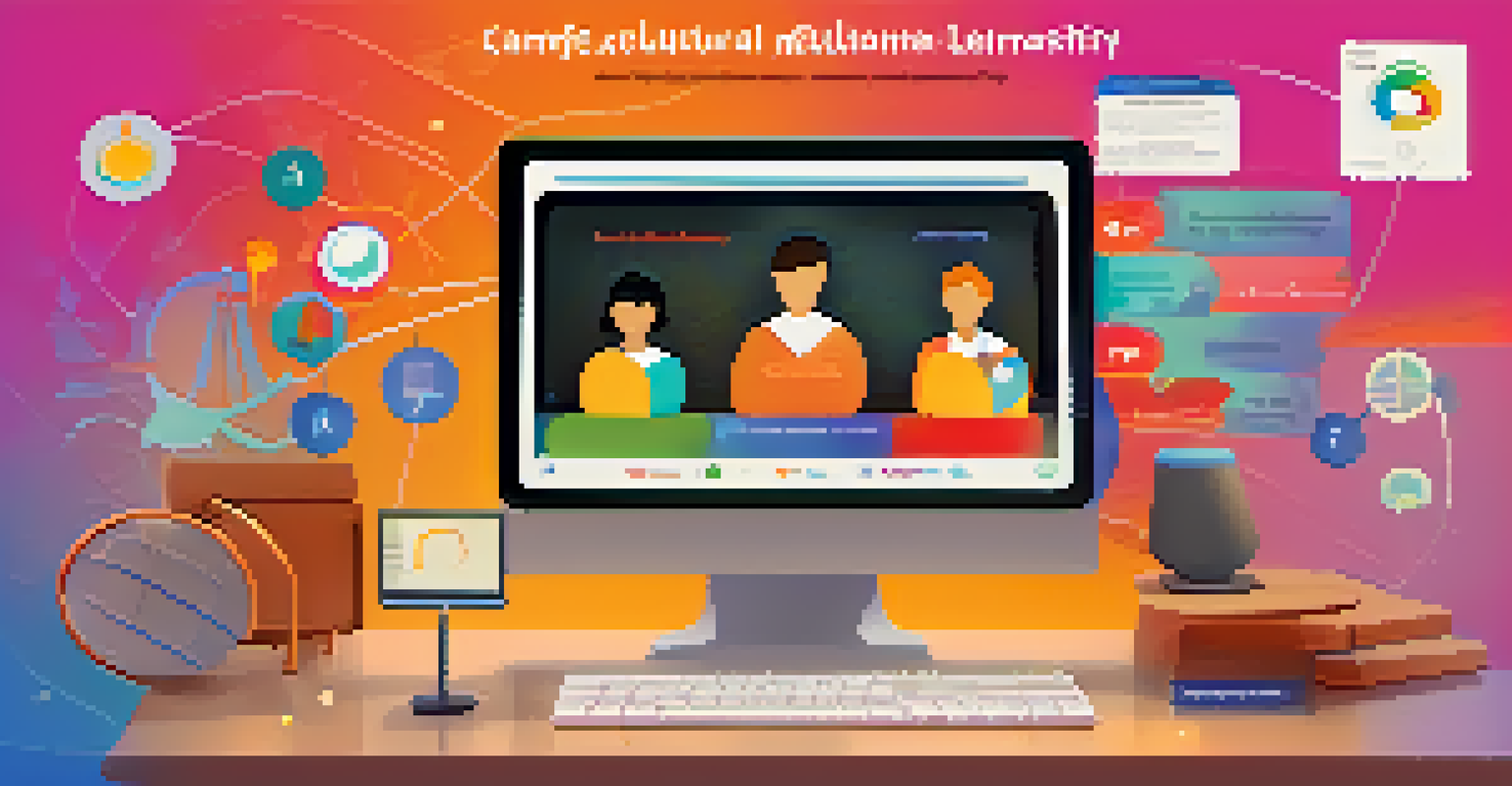Cultural Competence in EdTech: Inclusivity in Learning

Understanding Cultural Competence in Education Technology
Cultural competence refers to the ability to understand, appreciate, and interact with people from diverse backgrounds. In the context of educational technology (EdTech), this means creating tools and resources that are sensitive to various cultural perspectives. As classrooms become more diverse, the need for cultural competence in EdTech becomes increasingly important to foster an inclusive learning environment.
Cultural competence is the ability to understand, appreciate, and interact with people from cultures or belief systems different from one's own.
By designing educational tools that acknowledge and respect cultural differences, we can enhance engagement and learning outcomes for all students. This includes understanding different learning styles, communication methods, and values that different cultures bring to the educational experience. When EdTech providers prioritize cultural competence, they can better serve a wider range of learners.
Moreover, cultural competence goes beyond simply acknowledging diversity; it involves actively incorporating various cultural perspectives into the learning material. This can lead to more relevant and relatable content, ultimately enhancing student motivation and achievement. When students see themselves reflected in their learning tools, they are more likely to engage deeply with the material.
The Role of Inclusivity in EdTech Development
Inclusivity in EdTech means ensuring that all students, regardless of their backgrounds, have access to quality educational resources. This is crucial because students from marginalized or underrepresented communities often face barriers in traditional educational settings. By focusing on inclusivity, EdTech can help level the playing field and provide equitable learning opportunities for everyone.

When developers create inclusive EdTech solutions, they should consider factors such as language accessibility, cultural relevance, and adaptability to different learning needs. For instance, offering multilingual support can help non-native speakers feel more comfortable and included in the learning process. Similarly, educational content that reflects diverse cultures can engage students more effectively.
Cultural Competence Enhances Engagement
By incorporating diverse cultural perspectives into educational technology, we can improve student engagement and learning outcomes.
Inclusivity also involves seeking feedback from diverse user groups during the development process. By involving a variety of stakeholders—students, teachers, and parents from different backgrounds—developers can better understand the unique challenges faced by different communities. This collaborative approach can lead to more innovative and effective educational solutions.
Best Practices for Creating Culturally Competent EdTech
Creating culturally competent EdTech requires intentionality and a commitment to understanding the needs of diverse learners. One best practice is to conduct thorough research on the cultural backgrounds of your target audience. This can help identify specific challenges and preferences that should be addressed in the design process.
Inclusion is not a matter of political correctness. It is the key to growth.
Another effective strategy is to incorporate diverse perspectives in the content creation process. This can involve collaborating with educators and cultural experts who can provide insights into how to represent different cultures accurately and respectfully. By doing so, EdTech products can avoid cultural appropriation and instead celebrate diversity.
Finally, implementing continuous improvement practices is essential. Collecting and analyzing user feedback can help identify areas for enhancement. This ongoing dialogue with users ensures that the EdTech remains culturally relevant and responsive to the evolving needs of diverse learners.
The Impact of Culturally Relevant Pedagogy
Culturally relevant pedagogy emphasizes the importance of connecting educational content to students' cultural contexts. By integrating students' cultural references into the curriculum, educators can enhance engagement and learning outcomes. This approach is particularly effective in EdTech, where interactive and personalized learning experiences can be designed to reflect students' backgrounds.
For example, an EdTech platform could include case studies, examples, or scenarios that relate to the cultural experiences of its users. This not only makes learning more relatable but also validates students' identities and experiences. When students see their culture represented, they are more likely to participate actively in their learning.
Inclusivity Levels the Educational Field
Focusing on inclusivity in EdTech ensures equitable access to quality resources for all students, particularly those from marginalized communities.
Additionally, culturally relevant pedagogy fosters critical thinking and awareness. Students are encouraged to reflect on their culture and its influence on their perspectives. This not only enriches their learning experience but also prepares them to engage thoughtfully in a diverse world.
Challenges to Achieving Cultural Competence in EdTech
Despite the benefits of cultural competence, several challenges can hinder its implementation in EdTech. One significant barrier is the lack of awareness or understanding of cultural issues among developers and educators. Without proper training and education, it can be difficult for stakeholders to recognize the importance of cultural competence and inclusivity.
Another challenge is the tendency to create one-size-fits-all solutions that do not account for the diverse needs of learners. This can lead to the perpetuation of stereotypes or oversimplified representations of cultures. It's crucial for EdTech developers to move away from generic approaches and invest in personalized content that respects and reflects the richness of various cultures.
Finally, limited resources and funding can restrict the ability to conduct thorough research or collaborate with diverse stakeholders. EdTech companies may prioritize profit over inclusivity, leading to products that overlook the needs of marginalized communities. Addressing these challenges requires a commitment to prioritizing cultural competence at every stage of the development process.
The Future of EdTech and Cultural Competence
As the EdTech landscape continues to evolve, the emphasis on cultural competence will likely grow stronger. With increasing globalization and diversity in classrooms, there is a pressing need for educational tools that can adapt to the changing demographics of students. This presents an opportunity for EdTech developers to innovate and create solutions that are culturally responsive.
Emerging technologies, such as artificial intelligence and machine learning, can also play a role in enhancing cultural competence. These technologies can analyze user data to personalize learning experiences, ensuring that they reflect the cultural backgrounds of individual students. By harnessing the power of technology, EdTech can create more inclusive and engaging learning environments.
Continuous Improvement is Essential
Ongoing user feedback and collaboration with diverse stakeholders are key to creating culturally relevant and effective EdTech solutions.
Moreover, as educators and institutions recognize the importance of cultural competence, there will be greater demand for training and resources that support this goal. Collaboration between EdTech companies and educational institutions can lead to the development of best practices and guidelines that promote inclusivity in learning. The future of EdTech holds immense potential for creating an inclusive educational landscape.
Conclusion: Embracing Cultural Competence in EdTech
In conclusion, cultural competence is not just a buzzword; it's a necessary framework for creating inclusive EdTech solutions. By understanding and embracing diverse cultural perspectives, developers and educators can enhance the learning experience for all students. The journey toward cultural competence requires ongoing commitment, collaboration, and a willingness to learn from one another.
As we move forward, it's essential to prioritize the voices of marginalized communities in the development of educational technology. This ensures that EdTech not only serves a diverse audience but also empowers individuals from all backgrounds. Ultimately, creating a culturally competent learning environment can lead to better educational outcomes and a more equitable society.

Let’s champion cultural competence in EdTech, recognizing its potential to transform learning experiences. By fostering inclusivity, we can create an educational landscape that not only values diversity but also enriches the learning journey for everyone involved.